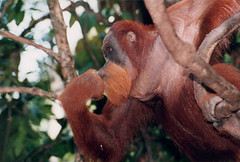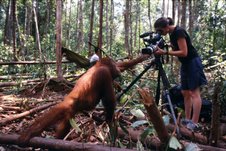Orangutans Rank No.1 - Most Intelligent Non-human Primate
ORANG-UTANS have been named as the world’s most intelligent animal in a study that places them above chimpanzees and gorillas, the species traditionally considered closest to humans.
The study found that out of 25 species of primate, orang-utans had developed the greatest power to learn and to solve problems.

Photo: Adult Male Sumatran Orangutan
Copyright Cockroach Productions www.cockroach.org.uk
The controversial findings challenge the widespread belief that chimpanzees are the closest to humans in brainpower. They also suggest that the ancestry of orang-utans and humans may be more closely entwined than had been thought.
“It appears the orang-utan may possess a privileged status among human kindred,” said James Lee, the Harvard University psychologist behind the research. “It is even possible that an orang-utan-like forager occupied a pivotal link in the chain of descent leading to man.”
Both orang-utans and chimpanzees share about 96% of their DNA with humans, although molecular studies suggest that chimpanzees are more closely related.
The study comes at a time when orang-utans are endangered as never before. Once widespread throughout the forests of Asia, they are now confined to just two islands, Sumatra and Borneo, and are highly endangered as a result of habitat loss and poaching.
Lee’s work involved collating a series of separate studies into the intelligence of different primate species. However, his research first had to overcome a much greater hurdle: would it be possible to compare different species of primates at all?
Spider monkeys, for example, have developed brains to cope with a fast-moving life in the tree tops, while slow lorises are small and leisurely nocturnal hunters.
The conventional belief is that comparing the intelligence of different species is meaningless because separate evolution over millions of years will have given them very different brains.
Lee, a junior psychology researcher at Harvard, found that in primates, at least, different rules seem to apply — the development of one set of mental skills seems to prompt the primate brain to develop other mental abilities as well.
“A primate genus with a high rank in an experiment testing particular mental abilities appears to have high ranks in all of them,” said Lee.
He also found that the single most important factor in deciding a species’ intelligence was simply the size of its brain: “The correlation of brain size with mental ability found in humans appears to extend throughout the primate order.”
This “remarkable finding” suggests, he said, that all primate brains work in much the same way, however they have evolved, allowing comparisons between species.
Lee’s research threw up some other surprises, too. Gorillas, for example, emerged as less intelligent than spider monkeys while baboons, often considered relatively bright, were ranked 14th.
Recent field work by Carel van Schaik, a Dutch primatologist who is now at Duke University, North Carolina, appears to bear out Lee’s findings.
Studying orang-utans in Borneo, he found them capable of tasks well beyond chimpanzees’ abilities — such as using leaves to make rain hats and leakproof roofs over their sleeping nests. He also found that in some food-rich areas the creatures had developed a complex culture in which adults would teach youngsters how to make tools and find food.
He and Lee both suggest that the key factor in such developments is the orang-utans’ life-style, spent mostly in the tops of trees where there is little risk from predators. This has allowed them to establish long and settled lives similar to humans’ and also to develop culture and intelligence.
In his own research papers, Van Schaik has suggested that since the ancestors of modern orang-utans split from the human lineage about 15m years ago, the seeds of human culture must go back at least as far.
Chris Stringer, professor of human origins at the Natural History Museum in London, agrees that the sociable lifestyles of primates are the driving force behind the development of intelligence. “Primates and early humans had not got the claws and teeth of predators so they had to rely on brainpower to communicate and protect themselves,” he said. “They are sociable creatures and living in small groups seems to have driven brain development.”
The idea that sociability and intelligence are linked is borne out by research into the relative brain power of diverse animal groups including cetaceans (whales and dolphins) and birds.
Dr Vincent Janik, of the sea mammal research unit at St Andrews University, said that some dolphin species had developed the ability to communicate far beyond that of great apes. “Dolphins have some abilities that great apes don’t have, such as copying new sounds. No primate apart from humans can do that,” he said.
Additional reporting: Max Colchester
Non-human primates in order of intelligence
1 Orange-utan
2 Chimpanzee
3 Spider monkey
4 Langur
5 Macaque
6 Mandrill
7 Guenon
8 Mangabey
9 Capuchin
10 Gibbon
11 Baboon
12 Woolly monkey





